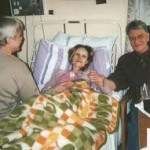Behavioral signs and symptoms of anorexia are
- obsession with nutrition, fats, and calories
- always thinking about food; dieting even when too thin already
- lying that you have already eaten when you haven’t yet
- eating in secret; and being ritualistic during eating.
Physical signs and symptoms are
- being too fixed on body image; drastic weight loss
- seeing one’s self as fat even when too thin and underweight already
- constantly pointing out flaws
- denial about thinness.
Signs and symptoms that you are
- purging are excessive exercising
- inducing vomiting after you eat
- and using diuretics, laxatives, and diet pills.
Several factors may cause this eating disorder. These can be controlling parents, perfectionism, stressful events, demanding careers, high levels of cortisol, low levels of serotonin and epinephrine, inability to express one’s feelings, history of abuse, eating disorder in the family history, troubled relationships, low self esteem, dissatisfaction with your body, and very strict diet plan.
When you are anorexic, you could experience fine hair growth on your face and body, dizziness, headaches, fainting spells, severe mood swings, overall body weakness, depression, tooth decay, poor memory, slow thinking, constipation, gum damage, brittle nails, and yellowish skin. By this time, you really need to undergo an effective anorexia treatment plan to save your health and life. Here are the steps that you could consider in making this possible:
1)Â Â Â Â Â Acceptance
 Acceptance and the actual admission that you have anorexia is the first step in the anorexia treatment plan. Here, you really acknowledge the fact that your health has to be improved. You are now able to accept the forms of help that are offered to you by the people around you.
Acceptance and the actual admission that you have anorexia is the first step in the anorexia treatment plan. Here, you really acknowledge the fact that your health has to be improved. You are now able to accept the forms of help that are offered to you by the people around you.
2)Â Â Â Â Â Express
 Telling someone that you have an eating disorder really helps you vent out your emotional problems and stresses about everything around you. This is a very important step in the anorexia treatment plan because by having people hear you out, they understand you more and will support you in every step that you will take to correct your disorder.
Telling someone that you have an eating disorder really helps you vent out your emotional problems and stresses about everything around you. This is a very important step in the anorexia treatment plan because by having people hear you out, they understand you more and will support you in every step that you will take to correct your disorder.
3)Â Â Â Â Â Avoid triggers
 There are things, activities, events, and people who trigger your eating disorder. To have an effective anorexia treatment plan, you should stay away from those that make you think about dieting excessively. You should be relaxed and be more focused on regaining your health.
There are things, activities, events, and people who trigger your eating disorder. To have an effective anorexia treatment plan, you should stay away from those that make you think about dieting excessively. You should be relaxed and be more focused on regaining your health.
4)Â Â Â Â Â Seek help
 Professional help is very important in an anorexia treatment plan. With a professional’s guidance and counseling, you are sure to get back on your normal eating habits in no time, as long as you follow instructions.
Professional help is very important in an anorexia treatment plan. With a professional’s guidance and counseling, you are sure to get back on your normal eating habits in no time, as long as you follow instructions.
5)Â Â Â Â Â Consider hospitalization
 Hospitalization is a welcome means to help you to get back to your normal healthy body weight. Medications and proper diet will be regularly provided more in the hospital until the ideal state of health is reached.
Hospitalization is a welcome means to help you to get back to your normal healthy body weight. Medications and proper diet will be regularly provided more in the hospital until the ideal state of health is reached.
6)Â Â Â Â Â Nutrition plan
 Having and maintaining a healthy plan in nutrition is very important toward the end of the anorexia treatment plan. This should be very well-maintained and should be considered a vital part of the lifestyle change of the reformed anorexic.
Having and maintaining a healthy plan in nutrition is very important toward the end of the anorexia treatment plan. This should be very well-maintained and should be considered a vital part of the lifestyle change of the reformed anorexic.
7)Â Â Â Â Â Counseling and therapy
 Counseling and therapy are the highlights of a good anorexia treatment plan. This gives you the reinforcement that you need to make the changes in your healthy dieting permanent.
Counseling and therapy are the highlights of a good anorexia treatment plan. This gives you the reinforcement that you need to make the changes in your healthy dieting permanent.
It is really difficult for an anorexia treatment plan to take flight when you don’t cooperate. You are the most important part of the treatment. Make sure that you do your part in making your eating habits healthy so that you may regain your confidence and normal body weight.
